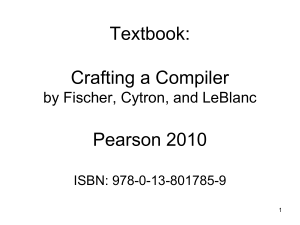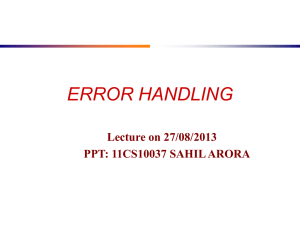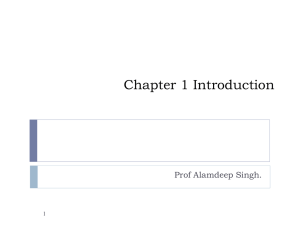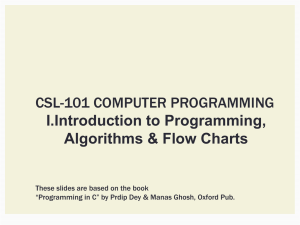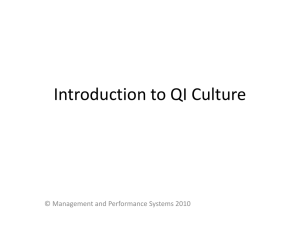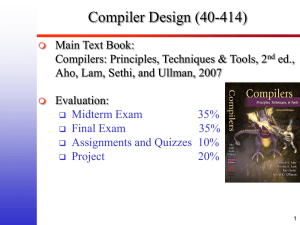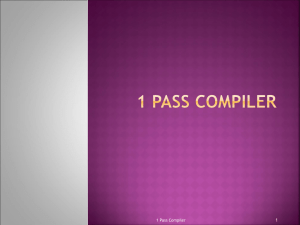CS 153: Concepts of Compiler Design
advertisement
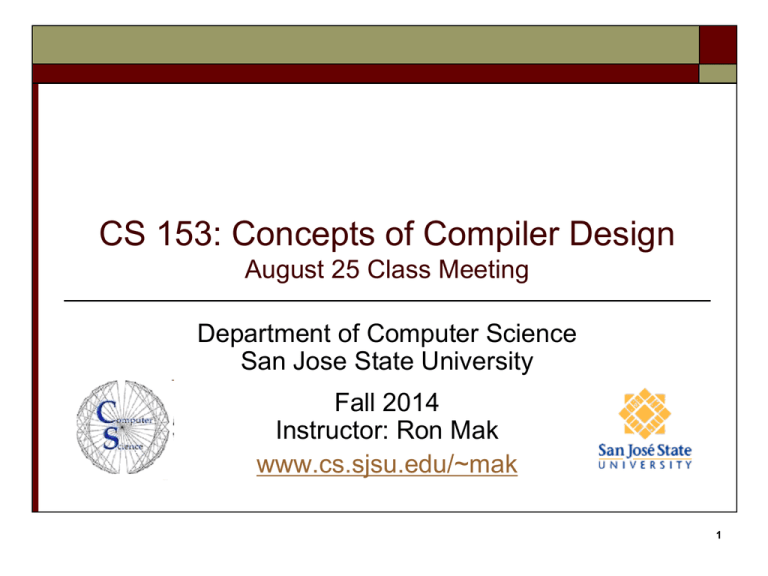
CS 153: Concepts of Compiler Design
August 25 Class Meeting
Department of Computer Science
San Jose State University
Fall 2014
Instructor: Ron Mak
www.cs.sjsu.edu/~mak
1
Goals of the Course
Understand the concepts of compilers
and interpreters.
Parser, scanner, tokens
Symbol tables, intermediate code
Executors, code generators
Compiler-compilers
_
Computer Science Dept.
Fall 2014: August 25
CS 153: Concepts of Compiler Design
© R. Mak
2
Goals of the Course, cont’d
Learn important job skills that employers want.
Work as a member of a small programming team.
Understand and modify a
Big Hairy Legacy Application.
Use modern software engineering practices to
develop a complex application.
_
Computer Science Dept.
Fall 2014: August 25
CS 153: Concepts of Compiler Design
© R. Mak
3
Course Notes
Class website
http://www.cs.sjsu.edu/~mak
Green sheet
Lecture notes and handouts
Assignments
_
Computer Science Dept.
Fall 2014: August 25
CS 153: Concepts of Compiler Design
© R. Mak
4
Required Textbooks
Java source code from the compiler textbook:
Writing Compilers and Interpreters, 3rd edition
http://www.apropos-logic.com/wci/
Second required textbook:
Generating Parsers with JavaCC, 2nd edition
(PDF)
http://generatingparserswithjavacc.com
_
Computer Science Dept.
Fall 2014: August 25
CS 153: Concepts of Compiler Design
© R. Mak
5
Compiler Magic?
C compiler:
int main()
{
printf("Hello, C world!\n");
}
Pascal compiler:
PROGRAM hello;
Java compiler:
BEGIN
writeln('Hello, Pascal world!');
END.
public class Hello
{
public static void main(String args[])
{
System.out.println("Hello, Java world!");
}
}
Computer Science Dept.
Fall 2014: August 25
CS 153: Concepts of Compiler Design
© R. Mak
Demo
6
Overview of the Compilation Process
hello.pas
What’s in this box?
Translation:
Pascal compiler
(you will write this in Java)
javac Hello.java ...
Jasmin assembler
(provided for you)
hello.class
binary
object program
Hello.class
Java linker & loader
(provided for you)
Execution:
Java compiler
hello.j
assembly language
object program
Translation:
Hello.java
Java Virtual Machine
Computer Science Dept.
Fall 2014: August 25
(provided for you)
Java linker & loader
java Hello ...
Java Virtual Machine
CS 153: Concepts of Compiler Design
© R. Mak
7
What is a Compiler?
A software utility that is extremely important
for developing applications …
… usually overlooked and taken for granted ...
UNLESS you can’t get your program to
compile!
_
Computer Science Dept.
Fall 2014: August 25
CS 153: Concepts of Compiler Design
© R. Mak
8
A Compiler is a Translator
A compiler translates a program
that you’ve written
... in a high-level language
... into a low-level language
C, C++, Java, Pascal, etc.
assembly language or machine language
... that a computer can understand
and eventually execute.
Computer Science Dept.
Fall 2014: August 25
CS 153: Concepts of Compiler Design
© R. Mak
9
Take roll!
Computer Science Dept.
Fall 2014: August 25
CS 153: Concepts of Compiler Design
© R. Mak
10
Assignment #1
Posted to the class web page:
http://www.cs.sjsu.edu/~mak/CS153/index.html
Write a simple Pascal program.
An individual (not team) assignment.
Due Wednesday, September 3.
_
Computer Science Dept.
Fall 2014: August 25
CS 153: Concepts of Compiler Design
© R. Mak
11
More Definitions
source program: the program (application)
that you write in a high-level language
which the compiler will translate
Usually stored in a source file.
source language: the high-level language in
which you write your source program
Pascal
_
Computer Science Dept.
Fall 2014: August 25
CS 153: Concepts of Compiler Design
© R. Mak
12
More Definitions, cont’d
object language: the low-level language
(AKA target language) into which
the compiler translates the source program
Do not confuse object language with
object-oriented language.
Jasmin assembly language
object program: your program after it has been
translated into the object language
_
Computer Science Dept.
Fall 2014: August 25
CS 153: Concepts of Compiler Design
© R. Mak
13
More Definitions, cont’d
target machine: the computer that will
eventually execute the object program
Java Virtual Machine (JVM)
The JVM runs on your workstation or laptop
(any computer that supports Java)
implementation language: the language that
the compiler itself is written in
Java
_
Computer Science Dept.
Fall 2014: August 25
CS 153: Concepts of Compiler Design
© R. Mak
14
Conceptual Design (Version 1)
Parser
Scanner
Controls the translation process.
Repeatedly asks the scanner
for the next token.
Repeatedly reads characters
from the source to construct
tokens for the parser.
Token
A source language element
Also reads from the source
Source
Computer Science Dept.
Fall 2014: August 25
identifier (name)
number
special symbol (+ - * / = etc.)
reserved word
The source program
CS 153: Concepts of Compiler Design
© R. Mak
15
Token
A low-level element of the source language.
AKA lexeme
Pascal language tokens
Identifiers
Numbers
integer and real (floating-point)
Reserved words
names of variables, types, procedures, functions,
enumeration values, etc.
BEGIN END IF THEN ELSE AND OR NOT etc.
Special symbols
+ - * / := < <= = >= > . , .. : ( ) [ ] { } ′
Computer Science Dept.
Fall 2014: August 25
CS 153: Concepts of Compiler Design
© R. Mak
16
Parser
Controls the translation process.
Repeatedly asks the scanner for the next token.
Knows the syntax (“grammar”) of the source
language’s statements and expressions.
Analyzes the sequence of tokens to determine
what kind of statement or expression it is translating.
Verifies that what it’s seeing is syntactically correct.
Flags any syntax errors that it finds and
attempts to recover from them.
_
Computer Science Dept.
Fall 2014: August 25
CS 153: Concepts of Compiler Design
© R. Mak
17
Parser, cont’d
What the parser does is called parsing.
It parses the source program in order to translate it.
AKA syntax analyzer
_
Computer Science Dept.
Fall 2014: August 25
CS 153: Concepts of Compiler Design
© R. Mak
18
Scanner
Reads characters sequentially from the source
in order to construct and return the next token
whenever requested by the parser.
Knows the syntax of the source language’s tokens.
What the scanner does is called scanning.
It scans the source program
in order to extract tokens.
AKA lexical analyzer
_
Computer Science Dept.
Fall 2014: August 25
CS 153: Concepts of Compiler Design
© R. Mak
19
Conceptual Design (Version 2)
We can architect a compiler with three major parts:
Computer Science Dept.
Fall 2014: August 25
CS 153: Concepts of Compiler Design
© R. Mak
20
Major Parts of a Compiler
Front end
Parser, Scanner, Source, Token
Intermediate tier
Intermediate code (icode)
Symbol table (symtab)
Only the front end needs to be
source language-specific.
The intermediate tier and
the back end can be
language-independent!
Computer Science Dept.
Fall 2014: August 25
“Predigested” form of the
source code that the back end
can process efficiently.
Example: parse trees
AKA intermediate representation (IR)
Stores information about the
symbols (such as the identifiers)
contained in the source program.
Back end
Code generator
CS 153: Concepts of Compiler Design
© R. Mak
Processes the icode and the symtab
in order to generate the object code.
21
What Else Can Compilers Do?
Compilers allow you to program in a
high-level language and think about your
algorithms, not about machine architecture.
Compilers provide language portability.
You can run your C++ and Java programs on
different machines because their compilers enforce
language standards.
_
Computer Science Dept.
Fall 2014: August 25
CS 153: Concepts of Compiler Design
© R. Mak
22
What Else Can Compilers Do? cont’d
Compilers can optimize and improve
the execution of your programs.
Optimize the object code for speed.
Optimize the object code for size.
Optimize the object code for power consumption.
_
Computer Science Dept.
Fall 2014: August 25
CS 153: Concepts of Compiler Design
© R. Mak
23
Course Overview
First half: Modify a Pascal interpreter.
The interpreter is written in Java
(the implementation language).
The source programs are written in Pascal
(the source language).
The implementation code for the interpreter
will be presented to you incrementally.
Midterm
_
Computer Science Dept.
Fall 2014: August 25
CS 153: Concepts of Compiler Design
© R. Mak
24
Course Overview, cont’d
Second half: Your compiler project.
JavaCC compiler-compiler
Java Virtual Machine (JVM) architecture
Jasmin assembly language
Back end code generator
Final
_
Computer Science Dept.
Fall 2014: August 25
CS 153: Concepts of Compiler Design
© R. Mak
25
Project Teams
Projects will be done by small project teams.
Projects may be broken up into assignments.
Form your own teams of 4 members each.
Choose your team members wisely!
Be sure you’ll be able to meet and communicate
with each other and work together well.
No moving from team to team.
Each team member will receive the same score
on each team assignment and team project.
Computer Science Dept.
Fall 2014: August 25
CS 153: Concepts of Compiler Design
© R. Mak
26
Project Teams, cont’d
Each team email to ron.mak@sjsu.edu
by Friday, August 29:
Your team name
A list of team members and email addresses
Subject: CS 153 Team Team Name
Example: CS 153 Team Super Coders
_
Computer Science Dept.
Fall 2014: August 25
CS 153: Concepts of Compiler Design
© R. Mak
27
Individual Responsibilities
You are personally responsible for participating
and contributing to your team’s work, and for
understanding each part of the work for every
assignment whether or not you worked on that part.
Computer Science Dept.
Fall 2014: August 25
CS 153: Concepts of Compiler Design
© R. Mak
28
